|
80x5 -
240x3 -
240x4 -
320x1 -
320x2 -
320x3 -
640x1 -
640x2
Set display option above.
Click on
images to enlarge. |
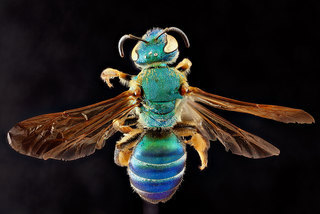
© Copyright source/photographer
· 9
Agapostemon splendens, -back 2012-06-25-14.08.53 |
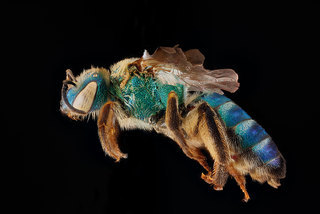
© Copyright source/photographer
· 9
Agapostemon splendens, -side 2012-06-25-14.31.50 |
|
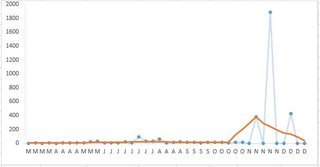
© Copyright source/photographer
· 9
Agapostemon splendens, Mid-Atlantic Phenology |
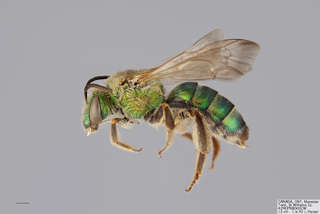
© Copyright Laurence Packer 2014
· 7
Agapostemon splendens FEM mm .x f |
|
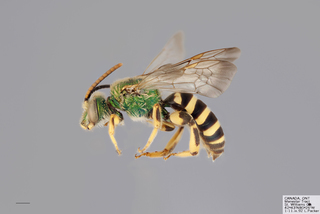
© Copyright Laurence Packer 2014
· 7
Agapostemon splendens MALE mm .x f |
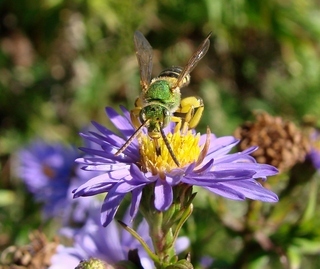
© Copyright John Ascher, 2006-2014
· 6
Agapostemon splendens, Shining Agapostemon sweat bee |
|
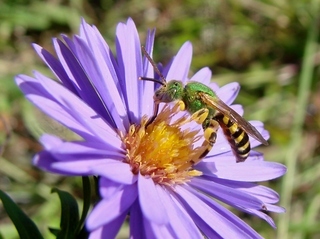
© Copyright John Ascher, 2006-2014
· 6
Agapostemon splendens, Shining Agapostemon sweat bee |
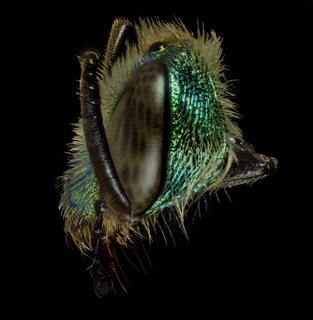
© Copyright source/photographer
· 5
Agapostemon splendens, f, faceside, anne arundel, md |
|
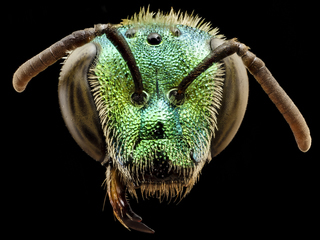
© Copyright source/photographer
· 5
Agapostemon splendens, f, head, anne arundel county, md |

John B. Pascarella, Valdosta State University, Georgia · 5
Agapostemon splendens, male, face |
|
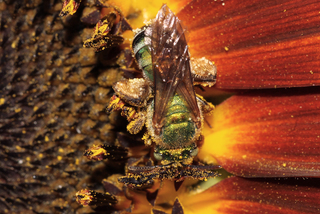
© Copyright Hadel Go 2014-2015
· 2
Agapostemon splendens |
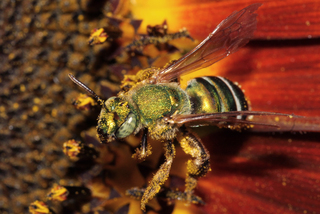
© Copyright Hadel Go 2014-2015
· 2
Agapostemon splendens |
|
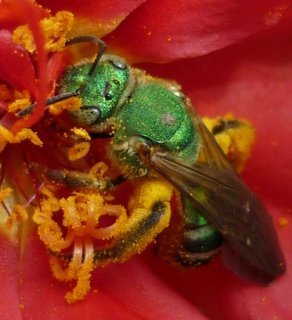
JC Jones · 1
Agapostemon splendens |
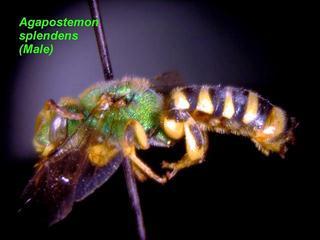
© John B. Pascarella, Valdosta State University, Georgia
· 1
Agapostemon splendens, male, side |
|
Overview |
Reprinted with permission from: Mitchell, T.B. 1960 Bees of the Eastern United States. North Carolina Agricultural Experiment Station Technical Bulletin No. 141.
FEMALE Length 10 mm.; entire body brilliant blue-green, abdominal terga more or less tinged with blue or purple; mandibles somewhat reddened; apical third of clypeus blackened, this portion sparsely punctate, basal greenish part closely punctate; supraclypeal area with rather fine, distinct and close punctures; face and vertex rather coarsely rugose; cheeks coarsely striate; pubescence of head and thorax above ochraceous, becoming more whitish below, more or less intermixed with fuscous on scutum; scutum finely and very closely punctate throughout, scutellum somewhat more shining, with minute, close punctures interspersed between much coarser and more sparse punctures, these becoming closer laterally; pleura coarsely reticulate, the metapleura more definitely striate; dorsal face of propodeum with a rather distinct, median, finely reticulate triangle, somewhat more coarsely reticulate on each side of this, lateral faces very finely and regularly striate, posterior face obliquely striate on each side of central line; legs largely piceous, front and middle femora yellowish apically, front tibiae more or less yellowish anteriorly; tegulae yellowish; wings quite uniformly pale brownish, veins and stigma more ferruginous; abdominal terga minutely and very closely punctate throughout, except that the basal pruinose area of terga 2-4 have rather sparse, distinct and deep punctures clearly visible, pubescence of discs very short and inconspicuous, largely pale on the more basal terga, becoming blackish on 3 and 4, tergum 5 entirely black pubescent.
MALE Length 11 mm.; head and thorax brilliant blue-green, abdominal terga piceous to black apically, more yellow basally; mandibles yellow, the tips reddened; labrum and apical third of clypeus yellow, clypeus green basally, this part closely and finely punctate, yellow apical part sparsely punctate; supraclypeal area strongly elevated, transversely rugoso-punctate; face finely and densely rugoso punctate; cheeks shining and rather smooth below, becoming rather obscurely striate above; scape yellow, flagellum ferruginous beneath, blackish above; pubescence of head and thorax ochraceous above, becoming somewhat paler below, that on scutum to some degree intermixed with fuscous; scutum and scutellum densely and rather finely rugoso-punctate; pleura coarsely reticulate anteriorly, more finely so posteriorly, metapleura irregularly striate; dorsal area of propodeum rather closely striate along the narrow, basal border, with an indefinite triangle, more finely reticulate on each side, lateral faces finely reticulate anteriorly, becoming rather coarsely striate posteriorly and below, posterior face irregularly reticulate; tegulae yellowish; wings uniformly pale brownish, veins and stigma more ferruginous; coxa and hind trochanters green, legs otherwise chiefly yellow, but mid femora piceous apically, tibiae with a piceous posterior blotch, hind femora very robust, length only about twice the breadth, with a fine, ventral tubercle; basal abdominal tergum piceous apically, very finely and closely punctate, apical impressed portion of discs somewhat suffused with bluish, pubescence of yellowish bands pale, that of the dark apical portions of discs subappressed and blackish; sterna 2-4 slightly swollen on each side just posterior to apical border, 5 straight apically, apical third yellow, 6 with a very faint, median, impressed line, the apical triangular point yellowish; ventral lobe of gonocoxite broad and expansive, with a conspicuous, apical fringe; gonostyli expanded dorsally and ventrally into flattened inner lobes between which they are deeply excavated, and bearing an apical slender stylus and a short basal truncate inner lobe; penis valves not keeled, with a subbasal constriction.
DISTRIBUTION North Dakota to Maine, south to Texas and Florida, April to October, with records in Florida of February, March and November.
FLOWER RECORDS Afzelia, Aster, Berlandiera, Bidens, Brassica, Cephalanthus, Chamaecrista, Chrysopsis, Cicuta, Cirsium, Coreopsis, Cucumis, Eupatorium, Euphorbia, Flaveria, Gaillardia, Galactia, Gelsemium, Gerardia, Haplopappus, Ilex, Ligustrum, Melilotus, Monarda, Opuntia, Pentstemon, Phaseolus, Polygonum, Prunus, Pyrrhopappus, Rhus, Silphium, Solidago, Stokesia, Trilisa, Vaccinium and Vicia. Robertson (1929) records splendens on the following additional genera: Blephilia, Claytonia, Osmorrhiza, Petalostemon, Salix and Verbena.
|
|
|
Identification | |
Extracted from: Roberts, 1972. REVISION OF THE BEE GENUS AGAPOSTEMON. Agricultural Experimental Station. The University of Kansas.
Halictus splendens Lepeletier 1841. Type $, Museum National D'Histoire Naturelle, Paris. Agapostemon aeruginosas Smith 1853. Type 2, British Museum (Natural History). Agapostemon splendens. Robertson, 1897.
I have seen the type of Halictus splendens, which was loaned to me by
Dr. S. Kelner-Pillault. The type of A. aeruginosas was examined by Cockerell, and more recently by Michener, and both believe it is conspecific with A. splendens.
Distribution (Fig. 19). Agapostemon splendens is the most common
species of Agapostemon in the southeastern United States and along the
Gulf Coast. It is also common in the sandy areas of the Central States and Michigan. It is found as far south as Veracruz, Mexico, as far north as southern Saskatchewan, Canada, and as far west as south-central Utah. In Canada females have been collected in May, June, July and August; males in August and September. In Kansas females have been collected from April through October and males from July through October. In Florida both sexes have been collected every month of the year. While more common at elevations of less than 2,000 ft. (610 m), A. splendens has been collected as high as 6,600 ft. (2,012 m) in the Great Smoky Mountains National Park in Tennessee and 3,700 ft. (1,127 m) near Wray, Colorado.
Diagnosis. The male may be distinguished from other species by its
toothed hind femora, the grooved basal ridge on its basitarsus, the apical stylus on its gonostylus, and its brown wings. The female may be distinguished from other species by its metallic green metasomal terga, rounded lateral pronotal angle, punctate mesoscutum and brown wings.
Description
male (Figs. 71-72, 166, 179, 200)
General coloration of head and mesosoma bright metallic green, meta-
soma with black and yellow bands. Head (Figs. 71-72): pubescence white, yellowish on vertex. (1) Labrum as in A. texanus. (2) Clypeus with large, shallow, scattered punctures on lower l/2, becoming contiguous above. (3) Interocular area with deep, contiguous, medium punctures below ocelli, becoming rugose laterally and below; sculpturing of supraclypeal protuberance like that of adjacent clypeal area. (4) Vertex with deep, contiguous, medium punctures anteriorly, becoming rugose laterally, posteriorly and between ocelli. (5) Genu with short coarse carinae extending dorso-laterally from antero-ventral margin. (6) Malar area bright yellow, short. (7) Mandible bright yellow, pale ferruginous on apical V4-V3- (8) Antenna black
above with yellow sometimes present on basal x A- x /i of scape and present on apical flagellomere; scape yellow below, pedicel with yellow spot on underside, and underside of flagellum pale amber. Mesosoma: pubescence yellow to amber on mesonotum and metanotum, white elsewhere. (9) Pronotum with lateral angle rounded and rugose above; postero-lateral area with large vertical carina just anterior to several irregular horizontal carinae. (10) Mesoscutum with coarse contiguous punctures becoming rugose anterolaterally. (11) Mesoscutellum with coarse contiguous punctures anteriorly, becoming rugose posteriorly. (12) Metanotum rugose. (13) Mesepisternum coarsely rugose anteriorly, only slightly less coarse posteriorly. (14) Metepisternum with very coarse irregular horizontal carinae or coarsely rugose. (15) Propodeum with propodeal carinae distinct; propodeal shield coarsely rugose; very coarsely rugose postero-laterally, becoming rugulose anterolaterally; coarsely rugose dorsally with triangular medial area depressed, rugulose. (16) Wing yellowish brown, conspicuously darker on distal x A- x /i\ veins and pterostigma amber to brown with radius conspicuously darker than other veins. (17) Tegula pale transparent amber with green tints interobasally and short transverse yellow band on anterior area curving rearward and almost reaching distal margin. (18) Fore leg yellow with coxa metallic green and trochanter with amber tints dorsally. (19) Middle leg yellow with metallic tints on coxa and dark brown streak centrally on posterodorsal surface of tibia. (20) Hind leg (Fig. 166) yellow; coxa and trochanter metallic green; femur with brown on apical x A- x /i of anterior, dorsal and posterior surfaces; tibia with brown posteriorly on distal l/2, anterodorsally on proximal l/2, basally, and apically on anterior and dorsal surfaces; basitarsus with amber on grooved portion of basal ridge and on apical groove. Metasoma: (21) Terga brown to brown-black with yellow bands on basal halves of terga 2-6, and with central yellow band on tergum 1; anterior face of tergum 1 pale amber to brown. Pubescence short, minute and dense on dorsal areas, brown-black on brown surfaces and white on yellow or amber surfaces; pubescence longer on anterior surface of tergum 1 and ventro-laterally on terga 5-7. (22) Sterna brown apically with varying amounts of yellow basally (always some yellow present); low, transverse, subapical ridge on sternum 4 (and sometimes 3) largest laterally; long, white, scattered pubescence on exposed areas. (23) Genitalia (Figs. 179, 200) with ventral lobes large and fringed with hairs distally.
female (Figs. 69-70)
General coloration of head, mesosoma and metasoma bright metallic
green to blue-green. Head (Figs. 69-70): pubescence white to yellowish
on clypeus and interocular area, becoming yellow to amber on vertex; white on gena. (1) Labium as in A. texanus. (2) Clypeus with large scattered punctures below, becoming subcontiguous on upper %. (3) Interocular area rugose with coarse contiguous punctures below ocelli; supraclypeal protuberance with coarse punctures and faint horizontal carinae. (4) Vertex with coarse contiguous punctures anteriorly, becoming rugulose laterally and between ocelli to rugose posteriorly. (5) Gena with coarse carinae extending postero-dorsally from antero-ventral margin. (6) Malar area very short, dark brown. (7) Mandible yellowish to amber with apical YrYz ferruginous. (8) Antenna dark brown to brown-black with underside of flagellum slightly paler. Mesosoma: pubescence white, becoming yellowish on mesonotum and metanotum. (9) Pronotum with lateral angle rounded; dorsal aspect of lateral angle and posterior lobe shallowly rugose; postero-lateral area with several carinae extending postero-ventrally and
anterodorsally. (10) Mesoscutum with coarse, deep, contiguous punctures becoming rugose antero-laterally (punctures sometimes appearing to be of two sizes as in A. texanus but surface never as shiny). (11) Mesoscutum with large scattered punctures and with much smaller contiguous punctures; central region just lateral to mid-line often shiny and devoid, or nearly devoid, of small punctures. (12) Metanotum rugose to rugulose. (13) Mesepisternum coarsely rugose. (14) Metepisternum rugose or with very irregular horizontal carinae. (15) Propodeum with strong propodeal carina; propodeal shield coarsely rugose or with irregular carinae extending dorsolaterally from medial groove. (16) Wing as in $ . (17) Tegula as in 6 but slightly darker amber. (18) Fore leg dark brown to brown-black; coxa metallic green; femur with pale yellow anteriorly, dorsally and posteriorly at apex; tibia with basal yellow spot dorsally and pale brown on anterior
surface; tarsus pale brown; pubescence white to amber. (19) Middle leg
like fore leg but with coxa largely brown and with pubescence brown-black dorsally on tibia and basitarsus. (20) Hind leg brown to brown-black, coxa with metallic tints dorsally; pubescence white to amber, becoming brown-black dorsally on tibia and basitarsus. Metasoma: (21) Terga bright metallic green to blue dorsally, becoming brown ventro-laterally and brown basally on tergum 1. Pubescence white, becoming black on terga 5-6; long ventro-laterally on anterior surface of tergum 1 and dorsally on terga 5-6; terga 2-5 with basal bands of white tomentum. (22) Sterna brown to brown-black with long white hairs scattered on exposed areas.
Extracted from: Robertson, C. (1897). North American Bees - Description and Synonyms. Transactions of the Academy of Science of St. Louis. Vol. 7. No. 14.
Female - Large, golden-green, the abdomen often showing bluish; metathorax with a triangular space on disc which is less coarsely reticulated; mesonotum densely and finely punctured, or more sparsely and coarsely so; scutellum with large scattered punctures, the intervening spaces densely and finely punctured, or shining and almost impunctate; wings uniformly rufo-hyaline, or the apical margins darker.
Male - Wings and metathorax as in the female; anterior and middle trochanters yellow, sometimes more or less blackish above and behind, posterior green, subcampanulate; femora yellow, usually with a little blackish at base behind, middle sometimes with spot at tip, posterior strongly incrassate, about one-half as wide as long; anterior and middle tibiae with a brownish streak behind, sometimes wanting on first, hind tibiae black at base, streaked beyond and with a spot at tip exteriorly, a streak towards tips within; abdomen black, with a brown spot at base, six fasciate, ventral segments with yellow basal fasciae, usually wanting on last, third from last short, thickened, widely emarginate, hind metatarsi presenting a dentiform angle. Length 11-13 mm.
The following are sex names of any one of the preceding species. It is fairly impossible to determine them without seeing the insects on which they were based. In that case the first two would probably replace names above adopted.
|
|
|
Names | |
|
|
| Supported by | |
|
Following served from Image from Cedar Creek Natural History Area |
Top | See original context
|
Following served from Jeff Hollenbeck, Bugguide, bugguide.net |
Top | See original context
Updated: 2024-07-27 01:41:28 gmt
|

